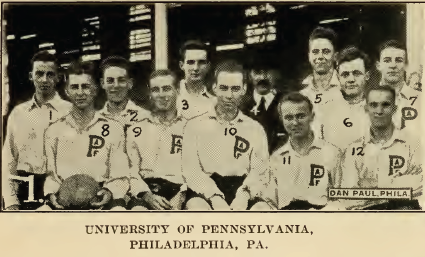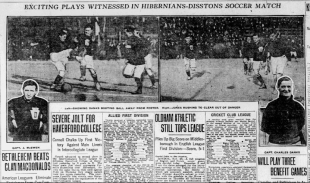Photo: Detail of Philadelphia Inquirer sports page, Nov. 29, 1914.
The long tradition of Thanksgiving Day soccer in Philadelphia continued on Nov. 27, 1914 with a second round American Cup match between Disston FC and Bridgeport FC of Connecticut.
Disston FC had formerly played as Tacony FC, the club’s name when it joined Philadelphia’s professional Pennsylvania League in 1905. In 1910 Tacony became the first Philadelphia team to win the American Cup tournament since the John A. Manz team in 1897. Undefeated in all competitions that year (with only two draws) the 1910 Spalding Guide called them the Team of the Year.
The Pennsylvania League folded after the 1913-14 season and was replaced by the American League as the home of the city’s top clubs. Among them were former Pennsylvania League clubs Hibernian, Victor AC (not to be confused with the Victor Talking Machine Company team, which was also a member of the league and based in Camden), and Disston AA, which the Philadelphia Inquirer referred to as “formerly Tacony.” Also joining the league was reigning Allied American League and American Cup champion Bethlehem FC, which had turned professional in August. As Disston AA, the team formerly known as Tacony enjoyed the support of the Disston Athletic Association, which was backed by the Disston Saw Works, an arrangement that may have been similar to what Bethlehem FC enjoyed with the Bethlehem Steel Company.
In the first round of the American Cup on Oct. 31, Disston had defeated Hibernian 5-1. In the second round at a windy Disston Field (formerly Tacony Ball Park) at State Road and Unruh Street, Bridgeport opened the scoring against the run of play, “scoring on one solitary breakaway after Disstons had bombarded Bridgeport’s citadel during thirty-five minutes of actual play,” the Philadelphia Inquirer reported on Nov. 27.
In the second half, Disston continued to pepper the Bridgeport goal, the Inquirer reporting, “If one had kept a correct account of the shots Disston tried for it would have tallied close to the half century mark.” Twenty minutes into the second half, a penalty kick was awarded to the home team after a handball in the penalty area. The Bridgeport keeper saved the penalty attempt from center halfback Kilpatrick, but outside right Burrows recovered the rebound and centered to inside left Kemp, who scored the equalizer “with a kick over his head.” Fifteen minutes later, center forward Lynch, who had scored a hat trick against Hibernian in the first round and had played for the Patterson True Blues the previous season, scored to give Disston the lead. Inside right Rogers added a third goal before the final whistle to give the home team the 3-1 win, and so advance to the third round of the tournament.
The Inquirer match report singled out Callis, the Bridgeport goalkeeper, for special praise, saying of the game, “In fact, it was Callis vs. Disstons”. The report continued, “There has been some clever exhibitions of goalkeeping given in this city during the last ten or twelve years, but it is a question if there has ever been one to compare with the exhibition that Callis treated the spectators to yesterday afternoon.”
The University of Pennsylvania also played on Thanksgiving Day, hosting Cornell. Penn finished the first half with a 1-0 lead, and added another goal in the second. Unfortunately, Cornell added two goals of their own in the second half and the game ended in a 2-2 draw. The result meant the end of the three-game winning streak Penn had enjoyed since the season start in the Intercollegiate Soccer League, which in addition to Cornell, also included Haverford, Princeton, Columbia, Yale, and Harvard.
Two other big games took place on the Saturday after Thanksgiving. In American Cup play, Bethlehem hosted Brooklyn’s Clan MacDonald, defeating them 2-0 in front of 1,500 home fans. The Philadelphia Inquirer reported on Nov. 29, “From the moment the whistle blew to start the game there was not a doubt but that Bethlehem was the superior team, although the visitors must be given all kinds of credit for the great defensive game played.”
In Philadelphia, Hibernian, who was in the midst of a rebuilding year with a forward line described by the Inquirer on Nov. 29 as “the youngest in the city in years,” exacted some revenge on Disston for the humiliating 5-1 loss suffered less than a month before.
Playing at their home grounds at Third Street and Lehigh Avenue, Hibs came out flying from the opening whistle, “fairly reveling on the hard ground which favored fast play.” Four minutes after the start of play, inside right R. Bergin scored the opener for the home team. While Disston equalized before the end of the half through inside right Foster, Hibernian outside right Coursey soon made it 2-1, tallying his fourth goal in three games. Disston continued to fight for another equalizer before Hibernian center forward Brown made it 3-1, the final score of the day.
The Inquirer was impressed with the young Hibernian forward line: “their play reminding one of the days when the Hibs were at the zenith of their career at the time such great teams as the Thistles, Corinthians, British-Americans and the Albions were factors in soccer in this city.” Also praised was the play of Hibernian left back Charlie Danks, “the old veteran, who was playing football before some of the present generation of soccerists were in knee pants.”



This is a great read. You could write a book on a number of subjects and it would be interesting- it is obvious you enjoy the research and there is strong command of language. Well done. Enjoy Thanksgiving Ed.
.
So very interesting to me how grass roots and homegrown the game was back in the early 1900s. We talk and, IMO, use the excuse of being a young soccer nation – to distance us from why it is we are not a great footballing nation yet. The game was vibrant and strong at least around these parts a long long long time ago and for some reason while it gained a toe hold world wide as the sport of the poor and national pastimes- it never quite took root similarly stateside I guess.
.
Watching Tyrus Cobb spike the second baseman and Ruth call his shot and Murders Row in the Bronx and any number of other baseball images is what we elected as the game of our imaginations.